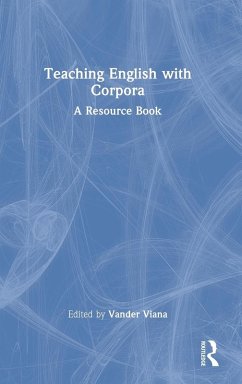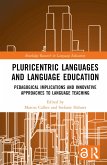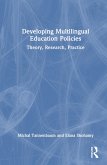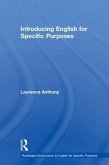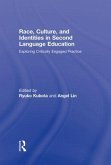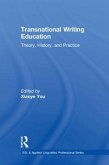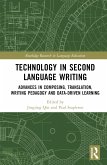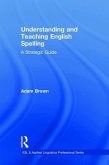Teaching English with Corpora
A Resource Book
Herausgeber: Viana, Vander
Teaching English with Corpora
A Resource Book
Herausgeber: Viana, Vander
- Gebundenes Buch
- Merkliste
- Auf die Merkliste
- Bewerten Bewerten
- Teilen
- Produkt teilen
- Produkterinnerung
- Produkterinnerung
Teaching English with Corpora is an accessible and practical introduction to the ways in which online and offline corpora can be used in English language teaching.
Andere Kunden interessierten sich auch für
![Pluricentric Languages and Language Education Pluricentric Languages and Language Education]() Pluricentric Languages and Language Education180,99 €
Pluricentric Languages and Language Education180,99 €![Developing Multilingual Education Policies Developing Multilingual Education Policies]() Michal TannenbaumDeveloping Multilingual Education Policies183,99 €
Michal TannenbaumDeveloping Multilingual Education Policies183,99 €![Introducing English for Specific Purposes Introducing English for Specific Purposes]() Laurence AnthonyIntroducing English for Specific Purposes206,99 €
Laurence AnthonyIntroducing English for Specific Purposes206,99 €![Race, Culture, and Identities in Second Language Education Race, Culture, and Identities in Second Language Education]() Race, Culture, and Identities in Second Language Education247,99 €
Race, Culture, and Identities in Second Language Education247,99 €![Transnational Writing Education Transnational Writing Education]() Transnational Writing Education204,99 €
Transnational Writing Education204,99 €![Technology in Second Language Writing Technology in Second Language Writing]() Technology in Second Language Writing182,99 €
Technology in Second Language Writing182,99 €![Understanding and Teaching English Spelling Understanding and Teaching English Spelling]() Adam BrownUnderstanding and Teaching English Spelling206,99 €
Adam BrownUnderstanding and Teaching English Spelling206,99 €-
-
-
Teaching English with Corpora is an accessible and practical introduction to the ways in which online and offline corpora can be used in English language teaching.
Hinweis: Dieser Artikel kann nur an eine deutsche Lieferadresse ausgeliefert werden.
Hinweis: Dieser Artikel kann nur an eine deutsche Lieferadresse ausgeliefert werden.
Produktdetails
- Produktdetails
- Verlag: Taylor & Francis
- Seitenzahl: 368
- Erscheinungstermin: 26. Oktober 2022
- Englisch
- Abmessung: 234mm x 156mm x 22mm
- Gewicht: 730g
- ISBN-13: 9781032252995
- ISBN-10: 1032252995
- Artikelnr.: 64103795
- Herstellerkennzeichnung
- Libri GmbH
- Europaallee 1
- 36244 Bad Hersfeld
- gpsr@libri.de
- Verlag: Taylor & Francis
- Seitenzahl: 368
- Erscheinungstermin: 26. Oktober 2022
- Englisch
- Abmessung: 234mm x 156mm x 22mm
- Gewicht: 730g
- ISBN-13: 9781032252995
- ISBN-10: 1032252995
- Artikelnr.: 64103795
- Herstellerkennzeichnung
- Libri GmbH
- Europaallee 1
- 36244 Bad Hersfeld
- gpsr@libri.de
Vander Viana is Associate Professor in Education, directs the Master's course in TESOL and is the founder/leader of the Language in Education Research Group at the University of East Anglia. His areas of research expertise include corpus linguistics, English for academic purposes, TESOL and language teacher education.
Table of contents
List of figures
List of tables
List of abbreviations
List of appendices
Acknowledgements
At-a-glance chapter taxonomy
Introduction
Corpora in and for TESOL
Vander Viana
Part A: English for General Purposes
1. Using concordance lines to teach participial adjectives
Sean Sutherland
2. Starting out with phrasal verbs
Rosie Harvey & Irene Marín Cervantes
3. Teaching collocations with 'Survey Says'
Robin Sulkosky
4. A grand problem and a jolly solution: Unmasking false friends with
corpus analysis
Natalie Finlayson
5. Raising awareness of first-language interference using parallel
corpora of subtitles
Elen Le Foll
6. If you speak English, take one step forward: Teaching conditionals
through kinesthetic activities
Riah Werner
7. Preposition repair: Empowering learners to fix their errors
Amy Tate
8. KWIC searches for quick answers: Solving word choice problems
Pamela Everly
9. She said she told him: Patterning in reported speech
Michael H. Brown
10. Using VocabProfilers to select texts for extensive reading activities
Thi Ngoc Yen Dang
11. Talking about the weather: Exploring adjective use with Sketch Engine
for Language Learning
John Williams
12. Food talks: Using corpus data to link cooking methods with types of
food
Vander Viana
13. Profiling let and make with the Corpus of Contemporary American
English
Ben Naismith
14. Corpus exploration of phrasal and Latinate verbs
Eric Nicaise
15. Minimal prep quizzes: Using online corpora to foster vocabulary
learning
Nick Canning
16. Helping learners identify high-frequency words
Shoaziz Sharakhimov & Ulugbek Nurmukhamedov
17. Writing online reviews
Natalia Mora-López
18. Exploring similes in corpus data
Natalie Finlayson
19. Exploring register variation in the use of indefinite pronouns
Irina Pandarova
20. Using corpora to explore varieties of English
Natalie Finlayson
21. Searching for frequent words for pronunciation activities
Roger W. Gee
22. Abstract nouns in picture descriptions
Tomá Mach
23. Tell me what your collocates are and I will tell you who you are
Tülay Dixon & Daniel Dixon
24. I feel kinda blah! Investigating language use in blogs
Maristella Gatto
25. I see what you mean: Exploring figurative uses of language
Sally Zacharias & Jane Evison
26. I was able to learn a new point: Examining the difference between
could and was/were able to
Martha Michieka & Theresa McGarry
27. Learning about words in use with StringNet Navigator
Anastasiia Kryzhanivska
28. Investigating adverbials in British English: Although vs. though in
spoken and written language
Lu Lu
29. Using Voyant Tools to enhance learners' reflections on their writing
Nausica Marcos Miguel
30. Gender equality in the TESOL classroom: Exploring news stories from
around the world
Vander Viana
31. Phrasal verbs in use: Investigating meaning and form
Vander Viana
32. Keywords in amateur online film reviews
Chad Langford & Joshua Albair
33. Formulaic language in amateur online film reviews
Chad Langford & Joshua Albair
34. Exploring semantic prosody with trainee teachers
Jenny Kemp & Luke Timms
35. A smile which melted her heart: Exploring metaphors in English
corpora
Wendy Anderson
36. Small words? Discourse markers in spoken language
Loretta Fung
37. I'm so sorry: Intensification in American English across time
Anne Barron
38. Thanking and responding to thanks in American English: Language
patterning and contextual appropriateness
Anne Barron
39. Whilst I do not object, I strongly believe... Exploring spoken
argumentative and persuasive discourse
Elen Le Foll
40. Register variation in newspapers: Working with multidimensional
analysis in English language teacher education
Vander Viana
Part B: English for Specific Purposes
41. Exploring terms in English for specific purposes
Nicole Brun-Mercer
42. Teaching verbs using learner-compiled corpora
Peter Dye
43. Is there a better choice? Verb-noun combinations in academic writing
Valdenia Almeida, Barbara Malveira Orfanò & Deise Dutra
44. Problem and solution markers: Exploring lexical combinations
Eman Elturki
45. Cloze exercises for mixed-ability groups: Using the Academic Word
List Gapmaker
Loretta Fung
46. Signaling transitions in academic writing
Nicole Brun-Mercer
47. Boosting your message: Using adverbs for impact in business writing
Linda Slattery, Catherine Prewett-Schrempf, Andrew Pullen & Matthew
Urmston
48. Using the British National Corpus to teach phrases from spoken and
academic English
Pawe¿ Szudarski
49. Using keyness to teach about academic speaking
Michael Suhan & Kyle Lucas
50. Teaching small-group academic discussions
Valeriia Bogorevich & Elnaz Kia
51. Which words should I look up? Identifying unknown high-frequency
words in English for academic purposes
Jenny Kemp & Laurence Anthony
52. Reflecting and acting on academic vocabulary use
Katie Mitchell Burrows
53. Which verb should I use? Disciplinary variation in reporting verbs
Joseph J. Lee
54. Using Google Scholar to support lexical choices in English for
academic purposes
Ulugbek Nurmukhamedov & Randall Sadler
55. Exploring collocations in the Corpus of Contemporary American English
Sharon Hartle
56. How can I be more specific in my writing? Exploring relative pronouns
in English for academic purposes
Jenny Kemp & Laurence Anthony
57. Don't write like that! Avoiding contractions in academic writing
Megan Bruce
58. Climate change or global warming? Analyzing, interpreting and
reporting findings
Robert Poole
59. Research findings for all: Popular science communication on global
challenges
Luciano Franco & Vander Viana
60. Exploring the speech act of confirming/verifying information in the
Michigan Corpus of Academic Spoken English
Ildiko Porter-Szucs
61. Identifying noun-verb patterns in scientific abstracts
Mónica Rodríguez-Castro & Spencer Salas
62. Using a concordancer to teach how to write about results
Tatyana Karpenko-Seccombe
63. Using corpora to explore vocabulary for writing conclusions
Tatyana Karpenko-Seccombe
64. Finding your academic voice: Use of nominalizations in academic
writing
Megan Bruce
65. Investigating complex noun-noun modification in academic prose
Sabrina Fusari
66. Exploring adverbs for cohesion and critical voice
Andrew Drummond
67. Exploring discipline-specific and paper-specific vocabulary
Anastasiia Kryzhanivska
68. Language patterns and rhetorical moves in research papers
Eman Elturki
69. Investigating references to a celebrity in a do-it-yourself obituary
corpus
Rudy Loock
70. Thanking politely and saying no gracefully to business invitations
Lisa Leopold
About the contributors
Index
List of figures
List of tables
List of abbreviations
List of appendices
Acknowledgements
At-a-glance chapter taxonomy
Introduction
Corpora in and for TESOL
Vander Viana
Part A: English for General Purposes
1. Using concordance lines to teach participial adjectives
Sean Sutherland
2. Starting out with phrasal verbs
Rosie Harvey & Irene Marín Cervantes
3. Teaching collocations with 'Survey Says'
Robin Sulkosky
4. A grand problem and a jolly solution: Unmasking false friends with
corpus analysis
Natalie Finlayson
5. Raising awareness of first-language interference using parallel
corpora of subtitles
Elen Le Foll
6. If you speak English, take one step forward: Teaching conditionals
through kinesthetic activities
Riah Werner
7. Preposition repair: Empowering learners to fix their errors
Amy Tate
8. KWIC searches for quick answers: Solving word choice problems
Pamela Everly
9. She said she told him: Patterning in reported speech
Michael H. Brown
10. Using VocabProfilers to select texts for extensive reading activities
Thi Ngoc Yen Dang
11. Talking about the weather: Exploring adjective use with Sketch Engine
for Language Learning
John Williams
12. Food talks: Using corpus data to link cooking methods with types of
food
Vander Viana
13. Profiling let and make with the Corpus of Contemporary American
English
Ben Naismith
14. Corpus exploration of phrasal and Latinate verbs
Eric Nicaise
15. Minimal prep quizzes: Using online corpora to foster vocabulary
learning
Nick Canning
16. Helping learners identify high-frequency words
Shoaziz Sharakhimov & Ulugbek Nurmukhamedov
17. Writing online reviews
Natalia Mora-López
18. Exploring similes in corpus data
Natalie Finlayson
19. Exploring register variation in the use of indefinite pronouns
Irina Pandarova
20. Using corpora to explore varieties of English
Natalie Finlayson
21. Searching for frequent words for pronunciation activities
Roger W. Gee
22. Abstract nouns in picture descriptions
Tomá Mach
23. Tell me what your collocates are and I will tell you who you are
Tülay Dixon & Daniel Dixon
24. I feel kinda blah! Investigating language use in blogs
Maristella Gatto
25. I see what you mean: Exploring figurative uses of language
Sally Zacharias & Jane Evison
26. I was able to learn a new point: Examining the difference between
could and was/were able to
Martha Michieka & Theresa McGarry
27. Learning about words in use with StringNet Navigator
Anastasiia Kryzhanivska
28. Investigating adverbials in British English: Although vs. though in
spoken and written language
Lu Lu
29. Using Voyant Tools to enhance learners' reflections on their writing
Nausica Marcos Miguel
30. Gender equality in the TESOL classroom: Exploring news stories from
around the world
Vander Viana
31. Phrasal verbs in use: Investigating meaning and form
Vander Viana
32. Keywords in amateur online film reviews
Chad Langford & Joshua Albair
33. Formulaic language in amateur online film reviews
Chad Langford & Joshua Albair
34. Exploring semantic prosody with trainee teachers
Jenny Kemp & Luke Timms
35. A smile which melted her heart: Exploring metaphors in English
corpora
Wendy Anderson
36. Small words? Discourse markers in spoken language
Loretta Fung
37. I'm so sorry: Intensification in American English across time
Anne Barron
38. Thanking and responding to thanks in American English: Language
patterning and contextual appropriateness
Anne Barron
39. Whilst I do not object, I strongly believe... Exploring spoken
argumentative and persuasive discourse
Elen Le Foll
40. Register variation in newspapers: Working with multidimensional
analysis in English language teacher education
Vander Viana
Part B: English for Specific Purposes
41. Exploring terms in English for specific purposes
Nicole Brun-Mercer
42. Teaching verbs using learner-compiled corpora
Peter Dye
43. Is there a better choice? Verb-noun combinations in academic writing
Valdenia Almeida, Barbara Malveira Orfanò & Deise Dutra
44. Problem and solution markers: Exploring lexical combinations
Eman Elturki
45. Cloze exercises for mixed-ability groups: Using the Academic Word
List Gapmaker
Loretta Fung
46. Signaling transitions in academic writing
Nicole Brun-Mercer
47. Boosting your message: Using adverbs for impact in business writing
Linda Slattery, Catherine Prewett-Schrempf, Andrew Pullen & Matthew
Urmston
48. Using the British National Corpus to teach phrases from spoken and
academic English
Pawe¿ Szudarski
49. Using keyness to teach about academic speaking
Michael Suhan & Kyle Lucas
50. Teaching small-group academic discussions
Valeriia Bogorevich & Elnaz Kia
51. Which words should I look up? Identifying unknown high-frequency
words in English for academic purposes
Jenny Kemp & Laurence Anthony
52. Reflecting and acting on academic vocabulary use
Katie Mitchell Burrows
53. Which verb should I use? Disciplinary variation in reporting verbs
Joseph J. Lee
54. Using Google Scholar to support lexical choices in English for
academic purposes
Ulugbek Nurmukhamedov & Randall Sadler
55. Exploring collocations in the Corpus of Contemporary American English
Sharon Hartle
56. How can I be more specific in my writing? Exploring relative pronouns
in English for academic purposes
Jenny Kemp & Laurence Anthony
57. Don't write like that! Avoiding contractions in academic writing
Megan Bruce
58. Climate change or global warming? Analyzing, interpreting and
reporting findings
Robert Poole
59. Research findings for all: Popular science communication on global
challenges
Luciano Franco & Vander Viana
60. Exploring the speech act of confirming/verifying information in the
Michigan Corpus of Academic Spoken English
Ildiko Porter-Szucs
61. Identifying noun-verb patterns in scientific abstracts
Mónica Rodríguez-Castro & Spencer Salas
62. Using a concordancer to teach how to write about results
Tatyana Karpenko-Seccombe
63. Using corpora to explore vocabulary for writing conclusions
Tatyana Karpenko-Seccombe
64. Finding your academic voice: Use of nominalizations in academic
writing
Megan Bruce
65. Investigating complex noun-noun modification in academic prose
Sabrina Fusari
66. Exploring adverbs for cohesion and critical voice
Andrew Drummond
67. Exploring discipline-specific and paper-specific vocabulary
Anastasiia Kryzhanivska
68. Language patterns and rhetorical moves in research papers
Eman Elturki
69. Investigating references to a celebrity in a do-it-yourself obituary
corpus
Rudy Loock
70. Thanking politely and saying no gracefully to business invitations
Lisa Leopold
About the contributors
Index
Table of contents
List of figures
List of tables
List of abbreviations
List of appendices
Acknowledgements
At-a-glance chapter taxonomy
Introduction
Corpora in and for TESOL
Vander Viana
Part A: English for General Purposes
1. Using concordance lines to teach participial adjectives
Sean Sutherland
2. Starting out with phrasal verbs
Rosie Harvey & Irene Marín Cervantes
3. Teaching collocations with 'Survey Says'
Robin Sulkosky
4. A grand problem and a jolly solution: Unmasking false friends with
corpus analysis
Natalie Finlayson
5. Raising awareness of first-language interference using parallel
corpora of subtitles
Elen Le Foll
6. If you speak English, take one step forward: Teaching conditionals
through kinesthetic activities
Riah Werner
7. Preposition repair: Empowering learners to fix their errors
Amy Tate
8. KWIC searches for quick answers: Solving word choice problems
Pamela Everly
9. She said she told him: Patterning in reported speech
Michael H. Brown
10. Using VocabProfilers to select texts for extensive reading activities
Thi Ngoc Yen Dang
11. Talking about the weather: Exploring adjective use with Sketch Engine
for Language Learning
John Williams
12. Food talks: Using corpus data to link cooking methods with types of
food
Vander Viana
13. Profiling let and make with the Corpus of Contemporary American
English
Ben Naismith
14. Corpus exploration of phrasal and Latinate verbs
Eric Nicaise
15. Minimal prep quizzes: Using online corpora to foster vocabulary
learning
Nick Canning
16. Helping learners identify high-frequency words
Shoaziz Sharakhimov & Ulugbek Nurmukhamedov
17. Writing online reviews
Natalia Mora-López
18. Exploring similes in corpus data
Natalie Finlayson
19. Exploring register variation in the use of indefinite pronouns
Irina Pandarova
20. Using corpora to explore varieties of English
Natalie Finlayson
21. Searching for frequent words for pronunciation activities
Roger W. Gee
22. Abstract nouns in picture descriptions
Tomá Mach
23. Tell me what your collocates are and I will tell you who you are
Tülay Dixon & Daniel Dixon
24. I feel kinda blah! Investigating language use in blogs
Maristella Gatto
25. I see what you mean: Exploring figurative uses of language
Sally Zacharias & Jane Evison
26. I was able to learn a new point: Examining the difference between
could and was/were able to
Martha Michieka & Theresa McGarry
27. Learning about words in use with StringNet Navigator
Anastasiia Kryzhanivska
28. Investigating adverbials in British English: Although vs. though in
spoken and written language
Lu Lu
29. Using Voyant Tools to enhance learners' reflections on their writing
Nausica Marcos Miguel
30. Gender equality in the TESOL classroom: Exploring news stories from
around the world
Vander Viana
31. Phrasal verbs in use: Investigating meaning and form
Vander Viana
32. Keywords in amateur online film reviews
Chad Langford & Joshua Albair
33. Formulaic language in amateur online film reviews
Chad Langford & Joshua Albair
34. Exploring semantic prosody with trainee teachers
Jenny Kemp & Luke Timms
35. A smile which melted her heart: Exploring metaphors in English
corpora
Wendy Anderson
36. Small words? Discourse markers in spoken language
Loretta Fung
37. I'm so sorry: Intensification in American English across time
Anne Barron
38. Thanking and responding to thanks in American English: Language
patterning and contextual appropriateness
Anne Barron
39. Whilst I do not object, I strongly believe... Exploring spoken
argumentative and persuasive discourse
Elen Le Foll
40. Register variation in newspapers: Working with multidimensional
analysis in English language teacher education
Vander Viana
Part B: English for Specific Purposes
41. Exploring terms in English for specific purposes
Nicole Brun-Mercer
42. Teaching verbs using learner-compiled corpora
Peter Dye
43. Is there a better choice? Verb-noun combinations in academic writing
Valdenia Almeida, Barbara Malveira Orfanò & Deise Dutra
44. Problem and solution markers: Exploring lexical combinations
Eman Elturki
45. Cloze exercises for mixed-ability groups: Using the Academic Word
List Gapmaker
Loretta Fung
46. Signaling transitions in academic writing
Nicole Brun-Mercer
47. Boosting your message: Using adverbs for impact in business writing
Linda Slattery, Catherine Prewett-Schrempf, Andrew Pullen & Matthew
Urmston
48. Using the British National Corpus to teach phrases from spoken and
academic English
Pawe¿ Szudarski
49. Using keyness to teach about academic speaking
Michael Suhan & Kyle Lucas
50. Teaching small-group academic discussions
Valeriia Bogorevich & Elnaz Kia
51. Which words should I look up? Identifying unknown high-frequency
words in English for academic purposes
Jenny Kemp & Laurence Anthony
52. Reflecting and acting on academic vocabulary use
Katie Mitchell Burrows
53. Which verb should I use? Disciplinary variation in reporting verbs
Joseph J. Lee
54. Using Google Scholar to support lexical choices in English for
academic purposes
Ulugbek Nurmukhamedov & Randall Sadler
55. Exploring collocations in the Corpus of Contemporary American English
Sharon Hartle
56. How can I be more specific in my writing? Exploring relative pronouns
in English for academic purposes
Jenny Kemp & Laurence Anthony
57. Don't write like that! Avoiding contractions in academic writing
Megan Bruce
58. Climate change or global warming? Analyzing, interpreting and
reporting findings
Robert Poole
59. Research findings for all: Popular science communication on global
challenges
Luciano Franco & Vander Viana
60. Exploring the speech act of confirming/verifying information in the
Michigan Corpus of Academic Spoken English
Ildiko Porter-Szucs
61. Identifying noun-verb patterns in scientific abstracts
Mónica Rodríguez-Castro & Spencer Salas
62. Using a concordancer to teach how to write about results
Tatyana Karpenko-Seccombe
63. Using corpora to explore vocabulary for writing conclusions
Tatyana Karpenko-Seccombe
64. Finding your academic voice: Use of nominalizations in academic
writing
Megan Bruce
65. Investigating complex noun-noun modification in academic prose
Sabrina Fusari
66. Exploring adverbs for cohesion and critical voice
Andrew Drummond
67. Exploring discipline-specific and paper-specific vocabulary
Anastasiia Kryzhanivska
68. Language patterns and rhetorical moves in research papers
Eman Elturki
69. Investigating references to a celebrity in a do-it-yourself obituary
corpus
Rudy Loock
70. Thanking politely and saying no gracefully to business invitations
Lisa Leopold
About the contributors
Index
List of figures
List of tables
List of abbreviations
List of appendices
Acknowledgements
At-a-glance chapter taxonomy
Introduction
Corpora in and for TESOL
Vander Viana
Part A: English for General Purposes
1. Using concordance lines to teach participial adjectives
Sean Sutherland
2. Starting out with phrasal verbs
Rosie Harvey & Irene Marín Cervantes
3. Teaching collocations with 'Survey Says'
Robin Sulkosky
4. A grand problem and a jolly solution: Unmasking false friends with
corpus analysis
Natalie Finlayson
5. Raising awareness of first-language interference using parallel
corpora of subtitles
Elen Le Foll
6. If you speak English, take one step forward: Teaching conditionals
through kinesthetic activities
Riah Werner
7. Preposition repair: Empowering learners to fix their errors
Amy Tate
8. KWIC searches for quick answers: Solving word choice problems
Pamela Everly
9. She said she told him: Patterning in reported speech
Michael H. Brown
10. Using VocabProfilers to select texts for extensive reading activities
Thi Ngoc Yen Dang
11. Talking about the weather: Exploring adjective use with Sketch Engine
for Language Learning
John Williams
12. Food talks: Using corpus data to link cooking methods with types of
food
Vander Viana
13. Profiling let and make with the Corpus of Contemporary American
English
Ben Naismith
14. Corpus exploration of phrasal and Latinate verbs
Eric Nicaise
15. Minimal prep quizzes: Using online corpora to foster vocabulary
learning
Nick Canning
16. Helping learners identify high-frequency words
Shoaziz Sharakhimov & Ulugbek Nurmukhamedov
17. Writing online reviews
Natalia Mora-López
18. Exploring similes in corpus data
Natalie Finlayson
19. Exploring register variation in the use of indefinite pronouns
Irina Pandarova
20. Using corpora to explore varieties of English
Natalie Finlayson
21. Searching for frequent words for pronunciation activities
Roger W. Gee
22. Abstract nouns in picture descriptions
Tomá Mach
23. Tell me what your collocates are and I will tell you who you are
Tülay Dixon & Daniel Dixon
24. I feel kinda blah! Investigating language use in blogs
Maristella Gatto
25. I see what you mean: Exploring figurative uses of language
Sally Zacharias & Jane Evison
26. I was able to learn a new point: Examining the difference between
could and was/were able to
Martha Michieka & Theresa McGarry
27. Learning about words in use with StringNet Navigator
Anastasiia Kryzhanivska
28. Investigating adverbials in British English: Although vs. though in
spoken and written language
Lu Lu
29. Using Voyant Tools to enhance learners' reflections on their writing
Nausica Marcos Miguel
30. Gender equality in the TESOL classroom: Exploring news stories from
around the world
Vander Viana
31. Phrasal verbs in use: Investigating meaning and form
Vander Viana
32. Keywords in amateur online film reviews
Chad Langford & Joshua Albair
33. Formulaic language in amateur online film reviews
Chad Langford & Joshua Albair
34. Exploring semantic prosody with trainee teachers
Jenny Kemp & Luke Timms
35. A smile which melted her heart: Exploring metaphors in English
corpora
Wendy Anderson
36. Small words? Discourse markers in spoken language
Loretta Fung
37. I'm so sorry: Intensification in American English across time
Anne Barron
38. Thanking and responding to thanks in American English: Language
patterning and contextual appropriateness
Anne Barron
39. Whilst I do not object, I strongly believe... Exploring spoken
argumentative and persuasive discourse
Elen Le Foll
40. Register variation in newspapers: Working with multidimensional
analysis in English language teacher education
Vander Viana
Part B: English for Specific Purposes
41. Exploring terms in English for specific purposes
Nicole Brun-Mercer
42. Teaching verbs using learner-compiled corpora
Peter Dye
43. Is there a better choice? Verb-noun combinations in academic writing
Valdenia Almeida, Barbara Malveira Orfanò & Deise Dutra
44. Problem and solution markers: Exploring lexical combinations
Eman Elturki
45. Cloze exercises for mixed-ability groups: Using the Academic Word
List Gapmaker
Loretta Fung
46. Signaling transitions in academic writing
Nicole Brun-Mercer
47. Boosting your message: Using adverbs for impact in business writing
Linda Slattery, Catherine Prewett-Schrempf, Andrew Pullen & Matthew
Urmston
48. Using the British National Corpus to teach phrases from spoken and
academic English
Pawe¿ Szudarski
49. Using keyness to teach about academic speaking
Michael Suhan & Kyle Lucas
50. Teaching small-group academic discussions
Valeriia Bogorevich & Elnaz Kia
51. Which words should I look up? Identifying unknown high-frequency
words in English for academic purposes
Jenny Kemp & Laurence Anthony
52. Reflecting and acting on academic vocabulary use
Katie Mitchell Burrows
53. Which verb should I use? Disciplinary variation in reporting verbs
Joseph J. Lee
54. Using Google Scholar to support lexical choices in English for
academic purposes
Ulugbek Nurmukhamedov & Randall Sadler
55. Exploring collocations in the Corpus of Contemporary American English
Sharon Hartle
56. How can I be more specific in my writing? Exploring relative pronouns
in English for academic purposes
Jenny Kemp & Laurence Anthony
57. Don't write like that! Avoiding contractions in academic writing
Megan Bruce
58. Climate change or global warming? Analyzing, interpreting and
reporting findings
Robert Poole
59. Research findings for all: Popular science communication on global
challenges
Luciano Franco & Vander Viana
60. Exploring the speech act of confirming/verifying information in the
Michigan Corpus of Academic Spoken English
Ildiko Porter-Szucs
61. Identifying noun-verb patterns in scientific abstracts
Mónica Rodríguez-Castro & Spencer Salas
62. Using a concordancer to teach how to write about results
Tatyana Karpenko-Seccombe
63. Using corpora to explore vocabulary for writing conclusions
Tatyana Karpenko-Seccombe
64. Finding your academic voice: Use of nominalizations in academic
writing
Megan Bruce
65. Investigating complex noun-noun modification in academic prose
Sabrina Fusari
66. Exploring adverbs for cohesion and critical voice
Andrew Drummond
67. Exploring discipline-specific and paper-specific vocabulary
Anastasiia Kryzhanivska
68. Language patterns and rhetorical moves in research papers
Eman Elturki
69. Investigating references to a celebrity in a do-it-yourself obituary
corpus
Rudy Loock
70. Thanking politely and saying no gracefully to business invitations
Lisa Leopold
About the contributors
Index

